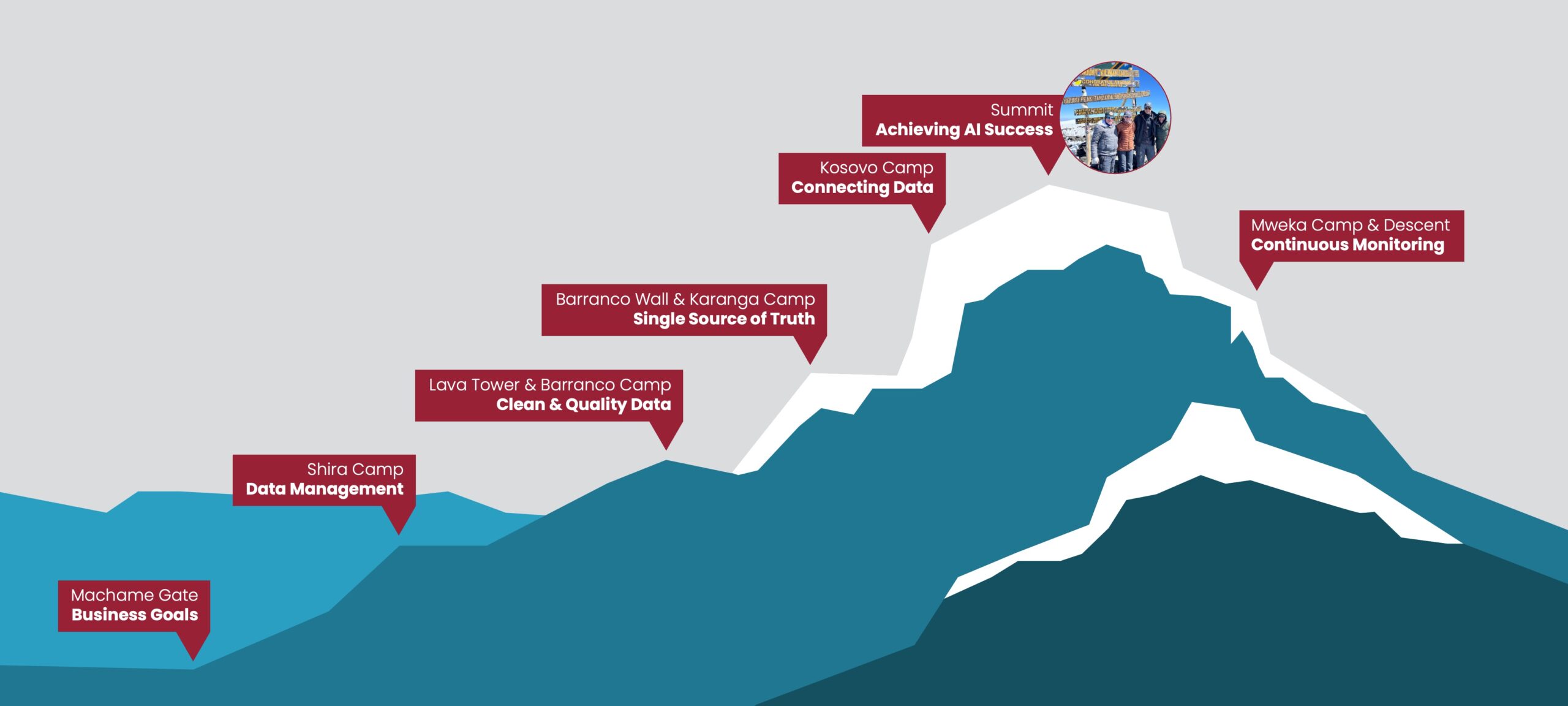Recently, I had the privilege of climbing Mount Kilimanjaro over seven days and six nights. The climb was as demanding mentally and emotionally as it was physically. Each stage of the trek presented unique challenges and lessons closely aligned with the stages of adopting AI in business. From the first steps through the rainforest to standing at the summit, the parallels to an AI journey were unmistakable. Each requires clear goals, strong foundations, and overcoming obstacles to achieve success.
Day 1: Machame Gate & Rainforest – Defining Business Goals
Our journey began at Machame Gate, where we set off into the lush rainforest, full of energy and anticipation. Similarly, when a company embarks on its AI journey, it starts by defining business goals and use cases. This is critical because having a clear direction ensures the journey is purposeful.
Just like we had to map out our climb and understand the terrain ahead, businesses must be crystal clear on what they want to achieve with AI. However, only 54% of AI projects make it from prototype to production according to Gartner. Often this is because companies fail to establish clear objectives and measurable outcomes at the outset. Whether it’s improving operational efficiency, enhancing customer experience, or driving innovation, having clear objectives is essential. Without a defined “summit” in mind, both the climb and AI adoption can become misdirected. This leads to wasted efforts and missed opportunities.
Day 2: Shira Camp – Building a Foundation with Strong Data Management
Day 2 led us out of the rainforest and up to Shira Camp. The terrain became more rugged, with sweeping views of the mountain. At this stage of the climb, careful management of resources and pace (Poli Poli as our guides reminded us) was crucial. This is just like in the AI journey, where strong data management is the foundation of success.
As we ascended, the need for organization and preparation became more apparent. For businesses, this means ensuring data is properly managed, organized, and accessible. Strong data management practices are the bedrock on which AI systems rely. Just as we couldn’t progress without proper logistics and gear, AI initiatives cannot move forward without a solid infrastructure for managing data.
Day 3: Lava Tower & Barranco Camp – Ensuring Clean and Quality Data
Day 3 brought us to Barranco Camp, where the altitude increased, and the challenges of breathing and acclimatization began to show. The air grew thinner (14,800 ft), and the challenges became more pronounced. Similar to the increasing complexity businesses face when handling large amounts of data. Here, clean and quality data becomes crucial.
At this stage of the AI journey, organizations must focus on ensuring their data is accurate, consistent, and ready for use. Gartner research shows that at least 30% of generative AI projects will be abandoned, with data quality issues being a key contributor. Much like the strain of the climb reminded us that we needed to be in peak condition, businesses need to ensure their data is clean and well-maintained to avoid flawed AI outputs. Without high-quality data, AI models risk underperforming, leading to decisions as unreliable as hiking with inadequate equipment.
Day 4: Barranco Wall and Karanga Camp – Mastering Data for a Single Source of Truth
The next challenge was the Barranco Wall, a steep and intimidating climb, followed by a trek to Karanga Camp. This stage of the hike required careful navigation, teamwork, and precise footwork. This is similar to the need for mastered data in the AI journey.
Just as the Barranco Wall demanded complete focus and the ability to rely on each team member, businesses must create a single source of truth for their data. This means standardizing, reconciling, and making data easily accessible across the organization. Without mastered data, departments can become siloed, leading to misaligned strategies and conflicting information. Like the climb, successful AI adoption relies on everyone having access to the same, accurate data to make well-informed decisions.
Day 5: Kosovo Camp (16,076 ft) – Connecting Organizational Data
By Day 5, we reached Kosovo Camp, perched high on the mountain and offering a view of the summit in the distance. At this stage, we had to mentally and physically prepare for the final push. For businesses, this is when connecting organizational data becomes vital.
Much like how we needed to be fully prepared for the final ascent, companies must ensure their data is seamlessly integrated across all departments. Gartner has found that 47% of organizations struggle with integrating data from multiple sources. Connected data allows AI to deliver a holistic view of the business. This breaks down silos and ensures everyone works from the same, comprehensive information. As we relied on each other and our equipment for the upcoming summit, businesses must rely on connected data to ensure a smooth and cohesive AI implementation.
Day 6: Kosovo Camp to Summit (Uhuru Peak) – Achieving AI Success
The morning of Day 6 was the most intense part of the journey. We set out in the cold, dark hours before dawn. We battled 35mph winds and pushed ourselves to the limit to reach Uhuru Peak (19,341 ft), the highest point in Africa. Reaching the summit was the culmination of all our hard work, preparation, and endurance, just like realizing AI success for a business.
For companies, this final stage is when AI begins to deliver real value. AI systems can now generate actionable insights, automate processes, and provide predictive analytics that lead to better decision-making. The ascent to the summit of Kilimanjaro mirrors the effort required to integrate AI fully into business operations, ensuring it scales, adapts, and delivers continuous value.
Just as reaching the summit required everything we had, achieving AI success requires a full organizational commitment. And like the exhilaration of standing at the top of Kilimanjaro, the rewards of AI – efficiency, innovation, and a competitive edge – are worth the journey.
Day 7: Mweka Camp and the Descent – Continuous Monitoring and Evolution
After reaching the summit, we began the long descent to Mweka Camp. In AI adoption, this is the stage where businesses must focus on continuous monitoring and evolution of their AI systems.
Much like the descent required careful attention to avoid injury, AI systems need ongoing monitoring and refinement to ensure long-term success. Businesses must remain agile, adjusting their AI models as new data becomes available and as market conditions change. Our descent was critical to the overall success of the climb. Similarly, continuous improvement is essential for maintaining AI’s effectiveness over time.
Conclusion: The Journey is as Important as the Destination
Climbing Kilimanjaro was an unforgettable experience that taught me lessons applicable both personally and professionally. Just like our trek, the AI adoption journey requires clear goals, solid data foundations, and perseverance in the face of challenges.
For businesses embarking on their own AI journey, it’s essential to remember that success doesn’t come overnight. It requires strong data management, clean data, organizational integration, and the ability to scale solutions. But much like standing on the summit of Kilimanjaro, the rewards of AI – improved decision-making, operational efficiency, and innovation – are well worth the effort.
 Chris Gately, Chief Operating Officer
Chris Gately, Chief Operating Officer

